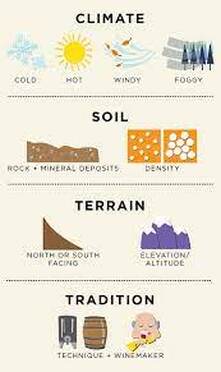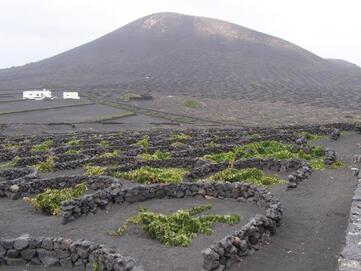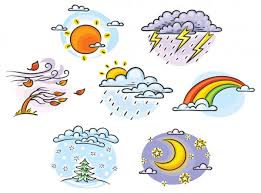 As a result of reading this surprising book "COMETIERRA" (EARTH-EATER) by Dolores Reyes, my mind began to be aware of earth and all the connections with it, mystical, metaphysical, mysterious and ancestral ... And from there, focusing on the subject wine / viticulture, this article came up. "Terroir" is a French term. Literally, it can be defined as a territory, a concrete, tangible and mappable space, which can be determined through various geological and geographical factors. When we refer to terroir in the world of wine, it is a slightly more romantic definition. It is a compendium between soil, climate, environment and other geographical characteristics, which give personality to that grape that has been grown there. The land and climate where the vines are grown are considered to impart unique characteristics to the fruits that could not be imparted by any other region of the world. In Spanish it is usually translated as "terruño", defining something deeper and at the same time more extensive. Terroir is the expression of a set of natural factors derived from the soil, topography and microclimate, all of them dedicated to the cultivation of the vineyard and under the action of the hand of man, the viticulturist is a very important part of the terroir, because throughout the years of cultivation of the vineyard, from the preparation of the land, to the successive plantations and start-ups, as well as the application of various cultivation systems and technologies, intervenes in such a way that makes a vineyard differentiate itself from those located in its environment and therefore also the wines made from it. The first to notice the deterioration of the meaning of “terroir” have been the Bourgogne makers. Bourgogne is known for its extraordinary mosaic of small parcels with unique and excellent characteristics for making wine. They are considered the best lands in the world, the "kings of terroir". However, they have looked for a new term and have developed a new concept to define their plots, "climat". Climat is a vineyard plot, carefully defined and known by name for centuries, which has its history and benefits from particular climatic and geological conditions. Each wine belonging to a “climat” has its own taste and its place within the Crus hierarchy (regional, town, Premier Cru or Grand Cru denomination). In Spain, they take the name of "Vinos de Pago" or "Vinos de Finca". One of the most influential aspects for making a wine is to choose the type of soil where the vine is grown. Factors such as aromas, flavours and the character of the wine grown in that land will depend on the characteristics of the soil where the plant grows. The incidence of the nature and characteristics of the cultivation soil on the quality of the wines is widely discussed by different authors and experts in the field. In many new areas or countries and regions starting in cultivation of vine, they tend to ensure that the soil, although important, is a purely secondary factor in relation to climate and variety, whereas in many of the famous regions of Europe the belief that a particular soil has a lot to do with local success is firm. There is no ideal terroir that can be applied to all vine varieties. The soil should not be very rich, so that the vine is not too vigorous and the grape not too large. This doesn´t mean that the soil should be lacking: balance is always important. By its nature, the terroir must be able to contribute certain organoleptic characteristics to the wine. Its poverty is a quality element of the wine, since it favours limited yields that avoid the dilution of the colorants, aromas and aroma components. Although all attempts to prove that there are substances that pass from the soil to the grape and to the wine have failed, it is likely that the nature of the soil determines the character of the wine. All these elements present in the soil, influence the final result of the wine. A correct combination of all of them, accompanied by the grape variety, the climate or the meteorology, will turn our grapes into differentiated wines depending on the type of soil. 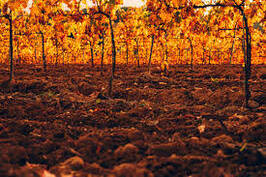 The characteristics expected in the wines according to the type of soil of where they come from are: Sandy soils: -Sand : Bright, soft, slightly alcoholic and aromatic wines. They are usually found in: Rias Baixas, Ribeiro, Ribeira Sacra, Wines of Madrid ... They are soils with a low content of silt and clay, and that generally do not have a much defined structure as they lack binding elements. In these lands there is very little cohesion, the water is not retained too much and the light penetrates easily, so they are usually very dry soils at hot times of the year. In this type of soils, winegrowers need to be very aware that the vine receives all the nutrients it needs and the ripening of the grape, because in this type of soil, the vineyards advance maturation a few days due to the heat accumulated in the soil due to penetrated light. 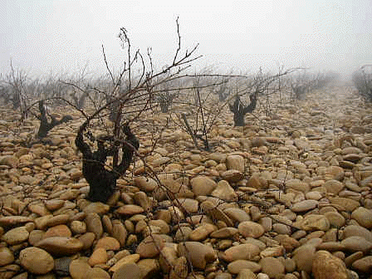 Clay soils: -Clay: slightly delicate and tannic wines -Limestone-clays: Delicate, elegant wines, little alcoholic -Ferruginous-clays: Alcoholic wines, high color They are usually found in: Rioja, Ribera del Duero, Calatayud, Alicante, Cigales, Somontano ... This type of ground is stronger; it has a higher silt and clay content than in sandy soils and they usually contain binding elements that prevent light from penetrating easily, so they are colder soils that delay somewhat more vine maturation. Stony soils: -Limestone-sand: Alcoholic wines, with mineral and dry aromas -Limestone: Wines with body, aging. They are usually found in: Galicia, Madrid, Méntrida…. In this type of soil, thick edges predominate on the surface, which gives freshness to the vineyard by preventing the light from penetrating deeply; therefore, they are very cold soils that give the vineyard great quality. Loamy soils: . Produces delicate and expressive wines They are usually found in: Serranía de Ronda, Almería, Córdoba ... Soils that have a balanced composition of clay, sand and silt, but with a higher proportion of the former, which allows good permeability and retention of water and nutrients. It is a soil that has a relatively uniform mixture, in quantitative terms, of the three separate textuals. Loamy-clay texture. It is a soil that presents a lot of clay but also has silt and sand, presenting greater cohesion. They are a very balanced type of terrain, a hybrid between stony and clayey ones. They have a good texture and fertility.  Slate soils: They are poor soils, with little organic matter, characteristic for expressing mineral aromas in the wines. In the Priorat (Catalonia) they call the disintegration of the slate in the form of sheets "llicorella". Where to find it: Priorat, Arribes de Duero, Ribeira Sacra, Tenerife, El Bierzo ... Volcanic soils: Where to find it: Tenerife, Priorat... Wine quality: Wines with smoky and mineral aromas. It filters the water very well, retains the sun's rays. In general we can say that no soil achieves all 100% of the characteristics mentioned above, but usually a combination depending on factors like the content silt or clay soil, drainage, depth, pH, salinity …etc. It is also important that we look at the texture of the soil, where we will mainly differentiate between compact soil and stony soil. A compact soil is not very appropriate for the cultivation of the vine, since it is not very permeable and does not absorb water correctly; on the contrary, the stony soil is perfect for the vineyard since it favours the growth of the vine by having excellent drainage and permeability. Other important aspects are the colour of the earth, which influences heating the ground: the clearer it is more freshness brings to the plant as it absorbs less extent rays of the sun to the dark earth, also the slope of the ground, a flat land is waterlogged more easily, while a pending risk eroding the slopes, however, can create special microclimates for the vineyard, more or less exposure to the sun, good drainage and little erosion. Another key factor that we have to consider is the mineral composition of the soil, as the minerals in it, bring certain characteristics to the wine, and are some of these that help make the character of the wine. Iron improves the blue tones in red wines, a soil rich in calcium will make our wines more elegant, since it influences the thickness of the skin and therefore the accumulation of aromas and pigments. Magnesium, for its part, contributes to harmony; silica provides graduation and finesse, while clay is responsible for structure and consistency. The climate affects important factors such as the temperature and the humidity of the soil, since the temperature and the precipitation will modify to a greater or lesser amount of minerals present and their chemical composition. Therefore, the climate affects endophogenesis, since thanks to rainfall there will be more or less biological and chemical activity on the soil. In addition, it is important to note that temperature is probably the most important climatic element when taking into account for the full development of the vine and the ripening of the grape, since temperatures that are too high for a long time could cause an increase in the grape sugars and consequently overripening, which is not suitable for making a quality wine. Irene Sayas
0 Comentarios
Deja una respuesta. |
irene sayasEntusiasta y conocedora de la magia del vino. El vino evoca, convoca y provoca... *Archivos:
|
Cómo contactarnos / How to contact usTeléfono 690 073 871 |
Suscribirse / SubscribeÚnete a nuestra lista de correo hoy!
Sign up to our mailing list now! |


